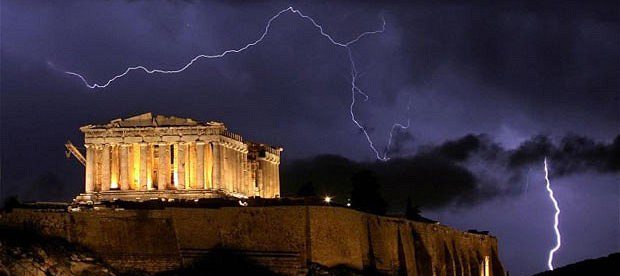City Fire Brigade – 1721 ~
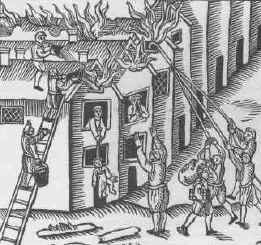
In July 1762, Alexander England, Blacksmith & newly Elected Overseer of the Town’s Water-engines, gave in his account of the Town’s Fire Apparatus. It consisted of:-
2 Water-Engines,
31 Leather Buckets,
3 Wooden Poles,
2 Iron Hooks,
4 Hatchets,
4 Hammers,
2 Crow-Irons,
2 Small Ropes
4 Heddars.
Mr England hinted at the inadequacy of the Apparatus as near Medieval, but the Magistrates felt no cause for Alarm.
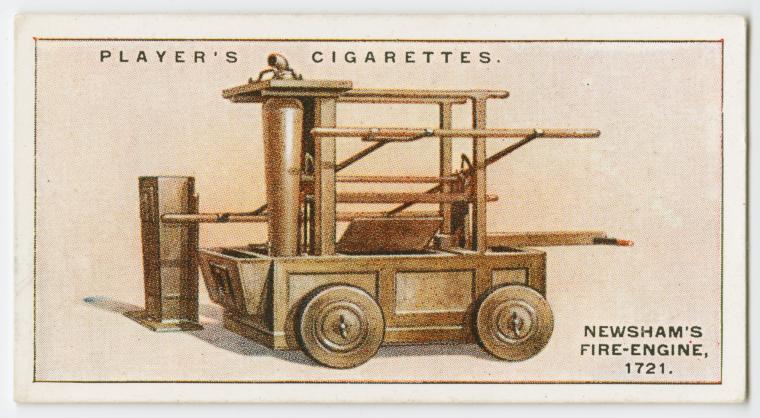
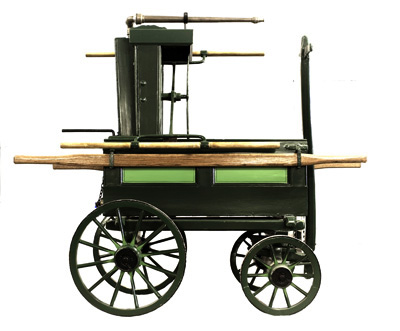
1721 Aberdeen’s First Fire Appliance
1762 Newsham Engine kept behind the Freemason’s Lodge (New Inn).
1776 Fire Appliance kept at the Water House in Broad Street
1776-1835 Insurance Companies subscribe to Fire Appliances
1835 Permanent base annual sum of £100

How Aberdeen Bought its 1st Fire Engine
Accordingly, the Council appealed to the Freemasons “for the liberty of access to carry out & install the Fire Engine by the back passage or entry to the Mason’s Lodge.” (New-Inn) The appeal was Granted & after a triumphal demonstration of the amazing efficiency of the New Machine – it could direct a jet of water upon an object 60–ft high from a distance of 50-yds. (Aberdeen Press and Journal, 14th June 1733).
Few citizens of Aberdeen today have any conception of the revolution which has been carried out in our Generation in the City’s Appliances for Fighting Fire. Fewer still realise how ill-equipped the Town was in this respect in the days when the danger of serious Conflagration was much greater than it is now.
Narrow Escape: Within a month their complacency was shattered, for the Town narrowly escaped heavy damages from Fire. It is evident from the tone of a Council meeting held early in September that the Townsfolk would not have held them Guiltless had their Property suffered badly from the Fire. Accordingly, it was agreed that a new & up-to-date Fire Engine must be Purchased. Fire Engines, however, were costly & the Magistrates, being as canny a set as any in the Land, were unwilling to undertake the whole expense of procuring a new one. Some argued that, since the Fire Insurance Company would suffer as much as, if not more than, the Town, were a disastrous Fire to occur, it would be to its advantage to help buy a New one. The good Burgesses were so pleased with this idea that they decided to send the Provost & Baillie Burnett, a wealthy Merchant & Ship Owner, to London to request the Insurance Company’s aid to procure a New Engine.
An Expedition: They set out towards the end of September bearing with them a letter to the Directors of the Sun Fire Assurance Company. This letter announced that “the Proprietors of Houses & of Merchandise in Aberdeen are willing to contribute towards Purchasing one of the best Fire Engines” if the Company would lend its Aid. They did not hesitate to press the point that it was in the Company’s Interests to do so, for its Loss “would indeed be heavy since all are insured by the Sun Fire Office & no one by any other Office whatsoever.” The Petition gave rise to a heated argument. It was an unheard-of thing, some asserted, to contribute to the Purchase of a parochial Fire Engine & it was a precedent they should hesitate to Establish. The Parishes of London furnished their own Fire Engines; why should not this little Northern Burgh do likewise? Others again reminded them that the precedent had already been established, for twice Grants of £15 had been made. Accordingly, after much talk & discussion, the Directors were persuaded to make a Grant of £25-provided £65-£75 were laid out altogether. The Company’s Agents appear to have been Impressed by the Aberdeen Burgesses’ Arguments & Consented.
Provost Pleased: The Provost was pleased with his work & perhaps not a little surprised at his success, “for“, as he wrote to the Council “the Parishes here do indeed furnish their own Engines.” In many a Scottish Town, on the other hand, it was not unusual for each Company that had a considerable number of Clients to keep its own Fire Engine there. When Fire broke out, all the Engines were rushed to the Rescue, but only the one of the Company whose Client was involved was put into Action – the others stood by Idle, unmoved by the unavailing efforts of a Rival Agency. The Provost wasted no time. He & Baillie Burnett, accompanied by one of the Company’s Clerks, set out immediately to buy a Bew Fire Engine. They tried several Firms & at length, “at Messrs Newsham & Ragg, Engine Makers to His Majesty & all Public Offices,” found a Model sufficiently up-to-date to please them.
Words Failed: Words, indeed, failed the Provost when he tried to write in praise of the Engine they had Bought, so he contented himself with sending the Baillies the Company’s “full descriptive Pamphlet.” Actually, the New Engine was not radically different from the old ones in the Town’s possession; nor, for that matter, from the one described by Hero of Alexandria in 150-BC, for the Fire Engine was one of the earliest examples of the application of Mechanical Science to useful purposes. Richard Newsham’s Engines (d.1743) were famous in Europe & America (one had been purchased for New York) he had devised a system of Pumping, which both filled the Tank & Emptied it, thereby dispensing with the laborious task of carrying water bucketful by bucketful. There were other improvements listed as “10 conveniences peculiar to Newsham’s Engines.” Among these we read that the Engine might stand upon the uneven ground without rocking; that the wheels never needed to be bolted & that they were particularly large to minimise the danger of the Cistern overturning. The narrowness of the Engine (the largest was only a yard wide) commended itself to Narrow-Street Towns since Carts might pass freely up & down removing goods that were in danger.
Perfect: The other convinces were connected with Mechanical detail & so perfect did they make the Engine that the Makers found they could “confidently assert that these Machines seldom go out of order if they are built up in accordance with the simple directions enclosed with each.” For this “marvellous Engine,” the Provost wrote, he had paid only £70, with an additional £3 for hose & buckets, lest, by chance, anything should interfere with the Suction. The Provost & Baillie then returned home to await the arrival of this New Toy. The next problem was where to House it. A regular Fire Station such as there is nowadays was, of course, undreamed of – an easily accessible Backyard or Close, with a shed to store buckets & ladders, were all they desired. Louise B. Taylor.
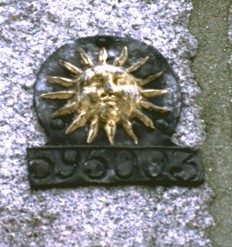
This Insurance Sign is attached to the Front Wall of 1-High Street, Old Aberdeen. It indicated that this House was insured with the Sun Fire Office. From May 1767 until the early-19thC it was common practice to attach a Fire Insurance ‘Mark‘ to Buildings. They were usually small Lead or Cast Iron Plates painted in various colours & attached to the front of a Building about 3M from the Ground. Each Fire Office had its own ‘Mark‘ or Plate, distinguished by the Emblem, Insignia or Motto of the Committee. Each Fire Insurance Office had its own Fire Brigade & when a Fire broke out, Teams of Firemen were guided by the ‘Mark’. Only the Company ensuring the Building fought the Fire unless it threatened other Buildings. Sun Fire Office was the 1st to Establish a Branch in Aberdeen
Aberdeen Fire Assurance Co (1801-1823): In those early-days, the people of Aberdeen would have fought Fire armed only with buckets of water to quell the Flames & long-handled hooks for demolishing the flimsily Built Houses, so creating a Fire Break in the Narrow Streets of the Town. In 1721 the Town Council appointed a Watchman to patrol the Narrow Streets & Closes during the hours of darkness, raising the Alarm should Fire break out. During the 18thC various Fire Insurance Companies Opened Agencies in the City of Aberdeen, the 1st being Sun Fire Office which commenced Business in 1738. Many others followed as the City grew in size. In 1762 the City Council Purchased a Fire Engine from London, for the princely sum of £65. Half the cost was borne by the Sun Fire Office. The 19thC saw 3-Insurance Companies Engaged in Fighting Fires within the City of Aberdeen, each with their own Engine & Crew of Firefighters. By 1826 these Insurance Companies were amalgamated to form the Aberdeen Engine Committee, headed by Lord Provost Hadden of Aberdeen. The Committee Organised & ran the Fire Brigade until 1835 when all Engines & Equipment were handed over to the Police Commissioners who had been Granted additional powers to take full charge of Fire-fighting in the City of Aberdeen. Fire Stations during the 19thC were little more than Sheds for holding the Fire Engines & Equipment safely undercover. The 5-‘Stations’ were located at Footdee, Mealmarket Street, King Street, Concert Court & George Street. Firefighters were summoned to Duty during daylight Hours by the Ringing of the Town House Bell; by night it was the Duty of the Watchman to rouse the Firefighters from their Homes. Most of the serving Firefighters at this time were Members of the Shore Porters Society, a Company established in the City of Aberdeen in 1498.

It was not until 1885 that the 1st Steam Fire Engine was purchased with a purpose-built Fire Station located in Frederick Street to Accommodate it. This was augmented in 1893 with a larger ‘Steamer’ named ‘PrincesMay’. The Firefighters of the City of Aberdeen Fire Brigade were still only part-time at this time, with the Firemaster undertaking the Duties of the Lighting Inspector & his Staff pursuing other vocations such as Roof Slaters, Chimney Sweeps, etc. In 1896 a full-time Professional Establishment came into Service under the Command of Firemaster Inkster & Deputy Firemaster Pullock. These Professional Firefighters set about reorganising the City of Aberdeen Fire Brigade & Recruiting men suitable for the work involved. The Fire Station located in Frederick Street was Found to be grossly inadequate for the running of a full-time Brigade & Plans were laid in 1897 for a New Fire Station to be Built at 256 King Street. This Station was Officially Opened in 1899 at a cost of £16,500. At the time of the opening, the City of Aberdeen Fire Brigade consisted of 4-Officers, 12-Firefighters & 8-Auxiliary Assistants. In 1905, Aberdeen City Fire Brigade Purchased Scotland’s 1st Motorised Appliance. By 1923 all of the Brigade’s Appliances were Motorised, heralding the end of the Horse-drawn Era in Aberdeen. by the 1930s, the Aberdeen City Fire Brigade was renowned as being one of the most modern, best equipped & up-to-date Fire Brigades in Britain, a trend that has been maintained right through to the present day. Grampian Fire Brigade continues to lead, with the acquisition of the latest appliances & equipment available on today’s Market.
It must be appreciated that Aberdeen in those days was considerably smaller than it is now. It was also about that period that Aberdeen possessed its 1st Fire Engine. Regrettably, there is no record as to the type of construction of the Appliance or where it was kept. It was not until the year 1776 that Records indicate that the 1st real Fire Station in Aberdeen was at a Building called the Water House in Broad Street (Inset – Waterhouse Clock) & the Appliance or Fire Engine was kept on the Ground Floor of the Building. There is no record as to whether or not the Fire Engine then was the same one of 1721.
17th, 18th & 19thC Fire Engines: A Company was originally Established in c.1690 by Nathaniel Hadley, manufacturing Pumps & Fire-fighting Apparatus. The 1st Fire Engine Factory was built in 1738. In 1791 Henry Lott joined the Firm & later took over full control of the Company & when he retired handed it over to his nephew by marriage, Moses Merryweather (1791-1872). He & his sons, including Richard Moses Merryweather (1839-1877) Managed the Business & it was known as Merryweather & Sons. In the 1830s Customers included Parishes & Vestries in London & beyond including Ireland, Fire Insurance Companies including Sun Fire Office & the Hand in Hand, for other Businesses & for Individuals mainly the Aristocracy. In the 1840s the Company was based in Long Acre. In 1862 a New Factory was Built in York Street, Lambeth, for the Manufacture of Steam-engines. In 1876 another Factory was Built in Greenwich Road, Greenwich & 3-yrs later the Lambeth Factory was Closed. The Company took Limited Liability Status in 1892 & became Registered as Merryweather & Co Ltd. By the later 19thC, Merryweather had become Fire Engine Makers by Appointment to the Royal Family & sold Fire-fighting Apparatus across the world.
Between 1776 & 1855 there were many Destructive Fires & the Townspeople were greatly alarmed at this serious state of affairs. In 1855 the Council decided to put the Fire Brigade on a permanent & efficient basis & they agreed to an annual sum of £100 be set aside for this purposes. Up to this time, Insurance Companies subscribed to keep up the Fire Brigade of Aberdeen. The type of Fire Engine in 1855 was a Manual Pump. That is a hand-operated Pump. This required 24-men, 12 on each side of the Engine, to operate the Pump Handles. Volunteers from the Spectators were always available to do this strenuous task. It is reckoned that 10 to 15 mins Pumping was enough to practically Exhaust most human beings.
Aberdeen Fire Brigade 1875: By the end of the 19thC the Brigade was run on a Part-time basis. Firemen were paid a retaining Fee but continued in their normal Jobs being called out to Fires either by the Ringing of the Town House Bell in the daytime, or being woken by the Town Night-watchman/Policeman. Assistance with major Fires was often sought from Soldiers Stationed in the Castlehill Barracks & from men from the Royal Naval Training Ship Clyde. Prior to 1885, when the City acquired its 1st Steam Fire Engine (Horse-drawn). Fires were fought with a Manual Fire Engine as inset pulled by 2-Horses. It required Water to be Pumped by hand by about 24 men – 12 on each side of a central Pivot. The men in the photograph appear to be posed in front of such an Appliance. Note that they did not have a full Uniform, is only provided with Helmets & Large Buckled Belts until 1887. The 2-Lum-hatted gentlemen are probably Officials. It was not until 1896 that the Fire Brigade was put on a more professional footing when William Inkster was Appointed as the City’s Firemaster & Firemen became full-time.
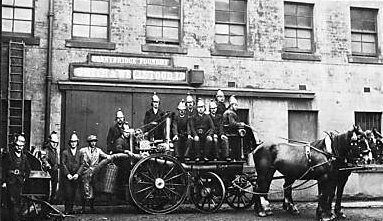
As time went on improvements were made on that type of Appliance but it was not until 1885 that Aberdeen provided itself with a Mechanical Appliance. This Fire Engine took the form of a Horse-drawn Steam-pumping Appliance & this was kept in the Fire Station which by this time had moved to Frederick Street. This Appliance did noble work up to the year l893 when a more up to date Fire Engine was installed. This Appliance was called the ‘Princess Mary!. This also was a Steam Appliance but with a much-improved Design. The Fire Station at Frederick Street was looked upon as the Acme of Perfection until the Spring of 1896 when a serious disaster occurred. Although the Fire Brigade was called a Permanent Brigade the Firemaster and the Personnel at that time carried out various other occupations (Retained). For instance, the Firemaster was also the Lighting Inspector & the remainder were Roof-slaters.

On receipt of a Fire-call, this meant that a Messenger had to be sent all over Town to look for the Firemaster, who in turn had to Hunt up his Assistants. Valuable time was thus wasted and it is not surprising that a serious Disaster eventually happened. This Fire took place in No.30 Marischal Street where the Brigade arrived approximately 1-hour after the Alarm was given and were too late to save some of the Occupants & the Building, which was Destroyed. As a result of the Disaster & the resultant outcry, the Town Council Established the Fire Brigade on a basis somewhat similar to the present arrangement where the Fire Calls were received at the Fire Station where the Personnel were available & they turned out very quickly after the Call was received. One has to bear in mind that at this Period the Fire Engines were Horse-drawn & a Call meant that the Horses had to be harnessed to the Appliance. This procedure took very few minutes, indeed the Horses being so well Trained that when the Fire Bell Sounded they knew exactly what was required of them & they positioned themselves as soon as the Stable Door was Opened.
Globe Fire, Life, & Annuity Insurance – Agent, Henry C Oswald, 30 Marischal Street c.1853

Some Fires, of course, were some distance from the Fire Station which meant the Horses had to Gallop this distance pulling this Heavy Fire Engine & possibly a Fire Escape Ladder & it was not unknown for an expendable Horse to Collapse and on occasion Die after reaching the Fire. In 1897 Plans where put in hand for the Building of a New Fire Station in King Street. This was to be known as the Central Fire Station & in 1899 this very impressive Granite Building was Officially opened by Rotarian, Sir Alexander Lyon, the Convener of the Lighting, Watching & Fires Committee at that time. The Staff consisted of a Firemaster, Deputy Firemaster, 11-Permanent & 10 Auxiliary Firemen. The Appliances at this time were 2-Horse-drawn Steam Pumps, 1-Horse-drawn Escape Ladder & 6-Horses. About this time a number of sub-Fire Stations were Opened in various parts of the City in the following places: – Torry, Woodside, Mile-End. In each of these Stations was kept a Hose Cart & Ladders, with a Fireman in Constant Attendance.

The ordinary Horsed Fire-Engine is simple in its Design & Parts. The Vertical Boiler contains a number of nearly horizontal Water Tubes, which offer a great surface to the Furnace Gases, so that it may raise Steam very quickly. The actual Water Capacity of the Boiler is small, and therefore it must be fed continuously by a special Pump. The Pumps, 2 or 3 in number, usually have Piston Rods working directly from the Steam Cylinders on the Plungers of the Pumps. Between Cylinders & Pumps are Slots in the Rods in which rotate Cranks connected with one another & with a Fly-wheel which helps to keep the Running steady. After leaving the Pumps the Water enters a large Air Vessel, which reduces the sudden shocks of delivery by the cushioning effect of the Air & causes a steady Pressure on the Water in the Hoses.
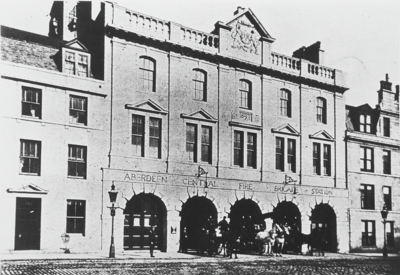
The Stations fulfilled a valuable Service that an Appliance of a sort complete with an experienced Fireman was on the scene of a Fire in those further reaches of the City much sooner than the Fire Engine from King Street which also turned out to the Fire. One must bear in mind that the City was not nearly as extensive as it is now. Nevertheless, the Transport was not as speedy as it is now & it was necessary to provide this Service. With the advent of Motor Fire Appliances which were Faster, the Brigade arrived more or less at the same time as the Fireman from the Substation & eventually the Substations were Closed down. What with the Traffic situation now, Fire Stations in Torry & Woodside may eventually be required. again.
But efficient as the “Horsed” Engine is, it has its limitations. Animal Strength & Endurance are not an indefinite quantity; while the Fireman grudges even the few short moments which are occupied by the Inspanning of the Team. In many Towns, therefore, we find the Mechanically propelled Fire Engine coming into favour. The Power for working the Pumps is now given a 2nd Duty of turning the Driving-wheels. A parallel can be found in the Steam-engine used for Threshing-Machines, which once had to be Towed by Horses, but now Travels of itself, dragging Machine & other Vehicles behind it. The earlier types of Automobile Fire Engines used the Boiler’s Steam to move them over the Road. A powerful Steamer, which can be turned out within a Minute of the Call, can travel at any speed up to 3-mph & can Pump 500 gal per min continuously. Its success has led to the Purchase of other Motor Engines, some fitted with a Chemical Apparatus, which, by the action of Acid on a solution of Soda in Closed Cylinders, is enabled to aim Water impregnated with Carbonic Acid Gas on to the Fire the moment it arrives within working distance of the Conflagration & gives very valuable “First Aid” while the Pumping Apparatus is being got into Order.

2–Motor Fire-engines Built by Merryweather, London. That on the left is driven by Petrol, and in addition to Pumping-gear carries a Wheeled Fire-escape. That on the right is driven by Steam. Both types are much faster than Horses, being able to travel at a rate of over 20–mph. As might reasonably be expected, the Petrol Motor has found a fine field for its Energies in connection with Fire Extinction. Since it occupies comparatively little space, more accommodation can be allowed for the Firemen & Gear. Furthermore, a Petrol Engine can be started in a few seconds by a turn of a handle, whereas a Steamer is delayed until Steam has been Generated. Merryweather had built a 4-cyl, 30-HP Petrol Fire Engine capable of a speed of 40-mph. It has 2-Systems of Ignition, the Magneto (or small Dynamo) & the ordinary Accumulator & Coil, so that Electrical Breakdowns are not likely to occur. A fast Motor of this kind, with a Pumping capacity of 300 gal per min, was a great improvement.

Deep Lift Pump. Morris LIM Emergency Tender RG6980
In the year 1905 Aberdeen Fire Brigade, as it was known, made another significant step with regard to modernisation. The Fire Committee bought a Motor Hose-reel Appliance from Merryweather, Greenwich, a Firm of Fire Engineers. This Appliance was reputed to be the 1st Motor Fire Engine in Scotland. Very useful work was carried out by this Machine & in March 1912 another Motor Appliance was added to the Brigade Fleet. This appliance was a 75-HP “Halley” which carried a 500-gal capacity Turbine Pump. The Purchase of this machine was virtually the beginning of the end of Horses in the Brigade. Four horses were dispensed with leaving only 2 to pull the Horse-drawn Escape Ladder or Steamers where necessary. The “Halley” Fire Engine attended most of the Fires in the City which varied from 160 – 210 calls per year.
Fire Engine Stations, c.1882
Central, King Street; Broad Street; Fountainhall Road; 101 Chapel Street; 92 Causewayend; Mid-Stocket Road; Short Loanings, Old Aberdeen & Great Northern Road, Woodside.
1906 – Merryweather Hose Reel Tender
Between 1921 & 1937 during the period that Firemaster F G Bell, MI Fire E, was in charge of the following Appliances & equipment was added:-
1912 1 Halley Motor Pump 500 gpm
1925 1 Morris Commercial Utility Tender.
1930 1-30 HP ‘Leyland Cub‘, Self Propelled Pump complete with hose reel & 30 ft. extension ladder. RG3712
1921 1-65 HP Dennis Pump Escape. RS4553
1922 1-65 HP “Halley” Self-propelled Pump complete with hose reel & 30 ft Ajax extension ladder. RS5222
1930 1-65 H.P. Leyland Metz 85 ft. Turntable Ladder.
1 Inspection Car. RG1066
1 Trailer Pump.
1 ‘Aberdeen’ Deep Lift Pump. Morris LIM Emergency Tender RG6980
1939 1 Bedford LIM
Fire Station – King Street
The Fire station in Kings Street was constructed during the tenure of Lord Provost Daniel Mearns, (hence Mearns Street) & cost £6,500. The building dates from 1807. The 23-Fire Fighters of the period had Horse-drawn Tenders, which did not completely disappear until the 1920s.
The strength of the Brigade had been increased as follows:-
1 Firemaster, 1 Deputy Firemaster, 18 Firemen, 1 Station Officer, 1 Station Attendant, 4 Auxiliary Firemen, 1 Motor Mechanic.
The Duty System in Operation during this period allowed each man one day off in every 4 of 17 hours & 24-hours respectively. Otherwise, the Personnel were on Duty. The working day is made up from 7 am – 4 pm on Station. From 4 pm they were allowed to go to their Homes which were nearby the Fire Station and in which Alarm Bells were installed. In the event of a Fire, the man receiving the call at the Fire Station rang the General Alarm Bell in the Station which was coupled to the Firemen’s Houses ringing them simultaneously. It was reckoned that during the time the Personnel were actually on the Station the average time for a turn-out to a call was 30-40 secs. During the stand-down period when the Personnel were at home sleeping the time taken was 80-90 secs. In the event of a Serious Fire, the Personnel who were off-Duty could be called for Duty.
There were also, throughout various parts of the City, Police Box Call points which could also be used to summon the Fire Brigade if it was required. The requirement in making an Emergency Call, from a Telephone Kiosk was merely to ask the Operator for the “Fire Brigade“. With the advent of the Automatic Telephone Exchanges it was necessary to bring in the present 999 facility. In 1938 an Auxiliary Service was instituted & this was known as the Auxiliary Fire Service (AFS). This Service was also later incorporated in the National Fire Service. During WW2, the Aberdeen City Fire Brigade was Nationalised as were all Fire Brigades in Britain in August 1941 & was from then on part of the National Fire Service (NFS). This situation remained until 1948 when the NFS was disbanded & the Brigades returned to the Local Authorities. At least in England & Wales, this was the case. In Scotland, Fire Areas were Established numbering 11 altogether. These were areas which consisted of Cities, Burghs & Counties grouped to form one area i.e. North-Eastern Fire Area consisted of the City & County of Aberdeen & the Counties of Moray & Nairn, Banff & Kincardine. The area involved was in the Region of 3,600 sq miles & was protected by the New North-Eastern Fire Brigade which had its Headquarters in Aberdeen. Fire stations were Established in Strategic parts of the area and each was responsible for a particular section. Apart from the whole-time Stations in Aberdeen at the Central Fire Station at King Street & a Temporary New Station at Anderson Drive, the remaining personnel were on a retained basis. That is to say, the men worked at their normal Employment but were available in the event of a Fire-call. They were summoned to the Fire Station by the sounding of a Siren (ex-air raid warning Sirens) during the day & call bells during the Night. These Sirens could be Operated by the General Post Office Telephone Staff on receipt of a Call or by the Local Police. As Telephone communications improved so the procedure for calling out the retained Personnel had to be altered. In the North-Eastern Fire Area, it was decided to centralise the Calls on to the Control Room at Brigade Headquarters. This enabled all Fire Calls to be routed directly to the Control in Aberdeen & the Sirens Operated from Area Control.
In 1968 a new Administrative Headquarters & Operational Fire Station manned by whole-time personnel was opened at North Anderson Drive. The Fire Station in King Street was still maintained Operational because of its strategic position in relation to the Fire Risk in that part of the City.
Firemasters
1835 to 1878 Firemaster W. B. Bolton
1878 to 1896 Firemaster Anderson
1896 to 1921 Firemaster William Inkster
1921 to 1941 Firemaster F. Bell
1941 to 1948 National Fire Service
1948 to 1953 Firemaster J. Ross
1953 to 1968 Firemaster W. Woods
1968 Firemaster J. Donnachie – From notes by Jimmy Slater
William Inkster, 1859-1933 Orkney Seafarer To Aberdeen Firemaster: An Exceptional Life. – Leslie Larnder. The son of an Orcadian Crofter, William Inkster left his Island home on Rousay at the age of 15 to be Apprenticed to a Stromness Boat Builder, before travelling the World as a Ship’s Carpenter on Clippers for some 8-yrs. In 1889 he Joined the London Fire Brigade, where the qualities he wrought in his Nautical Career were transferred to his new life. The author, considers that the achievements of Inkster & his men were “little short of miraculous”. To put it into context, in the early 1900s, to tackle a major Fire, Aberdeen Fire Brigade could call on 3-Steam Fire Engines, a Combined Hose Tender & Escape Ladder, plus 20-Firemen, of whom 10 were Auxiliaries. Nowadays, a similar Fire in a large City might bring out more than 20-Vehicles around 100- Firefighters. A kind man, though ambitious & apparently proud, that Inkster possessed qualities above & beyond most of his contemporaries is made clear by the fact that he was awarded the King’s Police Medal & was chosen by his Colleagues as President of the Association of Professional Fire Brigade Officers, a “singular honour & achievement”. Having begun his Career at a time when “a Fire Engine responding to an incident in Victorian times would have been an exhilarating sight with the Horses galloping & straining every sinew & clouds of vapour emerging from the Steam Fire Engine“, Inkster retired on the grounds of ill health in 1921 after a long, fruitful career. He subsequently went home to his native Orkney where, for a time, he sat on Kirkwall’s Town Council. – Illustrated with Photographs of relevant Sites in Orkney & Aberdeen & some early pictures of Fire-fighting Teams & Devices, this Account has been meticulously researched.
Torry Fire & Police Station, 1891
The 1st Fire Station in Torry was located at the Junction of Victoria Road & Sinclair Road. This was a wooden Building which incorporated Police Cells, as well as Fire Hose Reels and hand-drawn Ambulances. The decision to Erect this building had been taken as a consequence of the Amalgamation of Torry (along with Woodside & Old Aberdeen) into the City of Aberdeen in 1891. Prior to this, the area had come under the jurisdiction of Kincardineshire Police. Chief Constable Wyness planned a series of Sub-stations to be erected across the City. The one in Torry was made of Teak & similar to Glasgow’s sub-Police Stations.
Torry Police & Fire Station, 1898: In 1898 the Station was moved to the Torry side of Victoria Bridge. Today the Site is occupied by a Café. The Building again Housed both a Fire Station & a Police Station. The sub-Fire Station was equipped with 2-Handcarts, 1 with a 250-ft Hose reel, whilst the other carried 300-ft of Hose & 2-small Ladders. The Fire Station continued in use until the early-1920s when all sub-Stations within Aberdeen were closed & the Fire Service became fully Motorised.

Torry Auxiliary Fire Station, WW2: – Immediately prior to the outbreak of Hostilities, in 1939, 9 Locations within Aberdeen were selected to be Auxiliary Fire Stations. In Torry, the Site was Cordiner’s Garage on Menzies Road. A number of part-time Firemen were subsequently trained up & allocated to each of the Auxiliary Stations. The Auxiliary Station was issued with Trailer Pumps which were Towed by specially adapted Civilian Saloon Cars. Of the Fires attended by the Firemen from Cordiner’s perhaps the most notable was that at Victoria Road School on 30th June 1940, which had been caused by a German Incendiary Bomb. Inset – This was a Voluntary Service. Robert Fergus Abercrombie (2nd from left) was Firemaster. c.1940.
Don Barracks at the Bridge of Don, killing 27-Soldiers. That evening a total of 29 Dornier 217s of Kampfgruppe 2, Flying from Stavanger, dropped Bombs in and around Aberdeen, killing a total of 98-civilians.
The force with which a jet of water leaves the huge nozzle of a powerful engine is so great that it would seriously injure a Spectator at a distance of 50-yards. The “kick-back” of the water on the nozzle is sometimes sufficient to overcome the Power of one man to hold the Nozzle in position with his hands & it becomes needful to provide supports with pointed ends to stick into the Ground, or hooks which can be attached to the Rungs of a ladder.
Aberdeen recently made national headlines with their decision to paint Fire Service vehicles White. This ‘colour’ is cheaper than traditional Red paint. Grampian Fire Brigade now employs over 800 staff tackling over 8,000 Emergencies a year.
